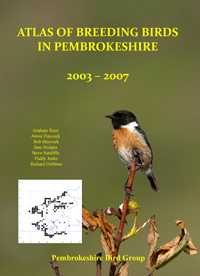Breeding resident and passage migrant
Both Mathew (1894) and Lockley et al. (1949) regarded the Meadow Pipit as a common resident. Although still a common species, it is now locally distributed (see map). It is probably less numerous than formerly, as sweeping changes in land management have taken place since the previous reviews, erstwhile suitable habitat being eradicated by the establishment of dairy and arable regimes. Breeding is now confined to the rougher areas of the coastal fringe, mountains, bogs and commons, and the islands and pockets of the least intensively farmed areas, such as Templeton airfield. At an estimated average density of 20 pairs per occupied tetrad, the total breeding population would be about 4,000 pairs.
There is a distinct passage between mid- February and April, when small parties of up to 20 are seen flying in off the sea from the south, passing through the western coastlands and islands and departing from the north coast between north-west and north-east. They frequently stop off to feed on the way and can accumulate into groups of 100 or more, but soon move on. They also pass at night, for about 20 were seen at the lantern of the South Bishop lighthouse on the night of 27 February 1976 and "a lot" on the following night.
Migrants begin to pass through again in August, with a peak in passage from September to mid- October, when up to 500 have occurred at Skomer and 1,000 at Skokholm, continuing on a diminishing scale into mid-November. They predominantly pass southwards and ringing returns show that some continue as far as France, Portugal and Spain. There is also a small north-westerly movement in October which may consist of birds moving to Ireland.
Meadow Pipits can be found on the tops of the Preseli Mountains during mild winters but not in colder weather, when they presumably descend to lower ground. Others are sparsely distributed across Pembrokeshire during the winter. A walk will reveal ones and twos per field but they sometimes gather into small groups at favoured spots, particularly at places that were recently covered by floodwater and at cattle feeding areas. They also frequent urban gardens in winter.
Severe winter weather causes an accumulation in coastal areas but it is not known whether these are from the immediate hinterland or represent birds from further east trying to keep ahead of advancing cold conditions. Prolonged bad weather causes hardship, for example 23 were found dead on Skomer in the cold of January 1962 (Harris 1962), and of dozens gathered in the farmyard at Southern Pitts (Garron) during snow in January 1985, attracted to gleanings of maize, barley and silage, many died and others fell victim to marauding cats.

Fieldwork 1984-88 (based on 478 tetrads)
Red = breeding confirmed = 96
Orange = breeding probable = 62
Yellow = breeding possible = 56
Total tetrads in which registered = 214 (44.8%)
Donovan J.W. & Rees G.H (1994), Birds of Pembrokeshire
 Friday, December 23, 2011 at 10:00AM
Friday, December 23, 2011 at 10:00AM 






